
'The Oleander Standard' (inset).
WHITNEY SMITH One of the things about your work that is inspiring for me is, when you are doing art relating to the female, the feminine, and the female in the world, there's a certain unbridled yet knowing part of you at play.
ROXANNA BIKADOROFF When you say unbridled, I think of what William Blake said, one of my favourite quotes: 'I must create a system or be enslaved by another man's; I will not reason and compare: my business is to create.’ As young artists, we often spend a lot of energy trying to figure out what group to belong to, but eventually we just have to say screw it and march to our own drummer. This is easier for some than for others. Also, as far as being able to make a visual impact goes, I don't want to be too comfortable. My mum once said, “There's always this little something in your work that is disquieting, a little twist of some sort.” It's kind of like that. For me the art needs to give the viewer a little pause, get under the skin. I’m not thinking about it when I do it, it’s more just a feeling, a certain resonance.
SMITH You are known both as an illustrator and as a fine artist. Does this process apply to both editorial illustration and painting?
I was an angry young woman and I had a pointy quill pen.
BIKADOROFF With magazine or book illustration — where the viewer is flipping pages — you have to capture people's attention right away and make a simple, powerful, impactful statement. So you don't want a lot of unnecessary detail. With painting for oneself, there is of course more room to play with areas of colour, technique, etc. But I think my paintings still have an illustrative quality, am still working that out. But the storyteller in me is always going to be there, in some form.
SMITH You worked for many years as an illustrator the nineties, a busy period period for editorial illustration, certainly compared to today. Did you have a lot of female colleagues in the business then?
BIKADOROFF There were a handful doing darkly political, feminist, more gritty stuff, but a lot of female illustrators were still working in more tasteful, or pretty styles. Or maybe it was just that women were still generally not being thought of to illustrate darker subject matter, I don't know. But I was an angry young woman, and I had a pointy, quill pen! I'm not that way anymore, because with age one does tend to feel more empowered and is taken seriously. Though I still have a healthy Lilith.

'Blue Saharan Sphinx.' 2013. (Acrylic, faux gold leaf and mixed media on wood.) 9 x 10 inches.
SMITH When you speak of your anger, is this anger related to male power and that sort of thing?
BIKADOROFF Yeah, patriarchy, but also just the general, wilful ignorance or lack of empathy for the opposite sex. I was born in 1964. My dad had come a long way, and was one of the most empathetic people you'd ever meet, but he was still of the 'father knows best' battle of the wills tradition. I had trouble with authority, in general, and became quite a rebel in my late years of elementary school, though I never got thrown out. I just didn't respect authority at all. So, there was that anger at 'the man', but there was also my own non-expressed, non-channeled creativity, a fire that built up and the only outlet for me was the visual artwork. Years later, I started belly dancing. That transformed and dissipated it.
But as far as being a woman in the illustration business, I dove right in into to the competitive, high stress arena of New York City, where intellect ruled. Though I was successful, doing what I thought I wanted to do, I was not happy. As a reaction, but also because I missed the West Coast, I then went all the way to the total opposite end of the spectrum — moving to San Francisco and going full Goddess, belly dancing, sewing beautiful, beaded costumes, doing Tarot and astrology and going for therapy, the whole California healing thing -- which was more about emotion and feeling. This also got me painting, because colour is totally emotional. At this stage, right now, I think the pendulum has slowed to a balanced, middle ground.
SMITH What led to you leave New York for the west coast?
BIKADOROFF I do remember one particular incident, though I wouldn't say it caused me to leave — rather it was a vision that put the experience of living in the big city in a metaphorical nutshell. People were always asking for money on the subway platform, but one day, just as I got off the train, there was this woman who wasn’t asking for money. She was on her knees — I think her hands might have been cupped in prayer, I forget — and there were tears streaming down her face, non-stop, like two waterfalls. She looked like a religious icon. I thought, “Oh, man, I'm too sensitive for this. I can't close myself off from this."

'Lilimoth.' 2019. Mixed media with vintage glass beads, sequins, fringe and hand embroidery. 7 x 10 inches.
SMITH It's an emotionally charged image. Did you ever do a draw a painting or an illustration of that woman?
BIKADOROFF No. It's like when people ask, do you ever draw or paint your dreams? It doesn't simply spew out like a painted Polaroid. Things have to go through a filter, permeate the unconscious, and that happens over time, then chances are something interesting will come out. It's similar to when I receive a magazine article that I’m illustrating. I take what is written in that article, the theme or message, and I process it through the right side of the brain or the subconscious or wherever the visual reptile resides, and I present a different sensory take on it. The viewer is led to see something in the article that maybe draws upon their own subconscious, not just a reiteration of what's written in the text. If I drew a picture of exactly what was in the article, it wouldn't conjure anything for the viewer.
SMITH Are you saying you avoid description and go for an image that welcomes interpretation?
BIKADOROFF Yes. An illustration has to come from a different place than where the text is coming from. It’s more dynamic that way.
SMITH If I was to try and describe your work to someone, I would underline the power with which you present female physicality and facial language through, to use a common term, a woman’s way of knowing the female.

'Painted Harpy.' 2017. Collage and acrylic on wood with vintage Italian metal frame. 9 x 6 inches.
"Harpies were death spirits, at one time the same as dakinis or Valkyries, but were demonized by the patriarchal Hellenists. Their vulture bodies ‘suggesting the Minoan funerary priestess’ feather costumes with bare necks and bosoms. Their name meant “snatchers” or “pluckers,” perhaps related to their use of the harp in funerary music, since the harp is played with plucking motions." — Barbara Walker
BIKADOROFF A lot of times men paint what Carl Jung would call their anima, their feminine side, their muse. They are painting the artist’s muse, which they almost always have painted. They need that outer inspiration, I think, but it's coming from within. It's a vehicle and it's projected onto the woman. But when women paint women, they are painting themselves. It's always self portraits. I'll give you a very rudimentary example, let's say there's a really sexy gym teacher . . .
SMITH Female?
BIKADOROFF Yes. And the guys — and perhaps some non-heterosexual young women — they all want to fuck her. [Laughs]
SMITH Very possible.
BIKADOROFF And the straight girls, they also have a crush on her, but it’s more because they want to be her. It's the same as when they go through the phase of having attractive fashion models posted on their walls — it's about a desire to morph with that woman, in whom they recognize their idealized self. It's not so much a sexual attraction as it is a mirror.

Why Aren’t We Shocked?', 2006. Ink/wash on paper. 5 x 3 inches.
SMITH I'd like to ask you about some of work, and how certain pieces came about. Let's start with ‘Why Aren't We Shocked?'
BIKADOROFF This was a 2006 illustration for an article of the same name in the magazine Rethinking Schools, by Bob Herbert. He starts by pointing out how more than one school shooter separated the girls from the boys, to kill only the girls. He then goes on to talk about the bigger issue, how we have become numb to images in advertising and media of women being abused or sexually submissive in some way, and how pervasive misogyny is in our culture.
I wondered what would still be a shocking image, in this respect and what came to mind was this highly recognizable and invaluable painting of a woman, 'La Gioconda' (Mona Lisa), but with a black eye. It's a dark, stark illustration, not meant to be ironic or funny, just an image to make people do a double take. But of course this was for a more liberal education publication, so not sure whether this image would be effective out in the mainstream. People are even more numb to imagery now, but at least things have changed as far as what advertisers can get away with. It has kind of swung in the other direction, where context isn't necessarily taken into account.

'Looking for Love.' 1992. Ink/wash on Arches paper. 8 x 10 inches.
SMITH This is one that is very striking for me, ‘Looking for Love,’ 1992.
BIKADOROFF It was for an article on the dating scene in Vancouver, by Zsuzsi Gartner.
SMITH But before online dating really got going.
BIKADOROFF Yes.
SMITH It has the feel of a candid, stolen moment of a photograph. It's beautifully executed, yet in a very casual somewhat cartoon style, but I find it very moving. It makes me really feel what she is feeling, even though we don’t see her face. Of course what she's wearing contributes to that as well.
BIKADOROFF When a friend of mine saw that the first thing she said was, “Oh, ugh. That feeling of too tight underwear!"
SMITH This is one of the things that intrigues me about your work — its presentation of a woman’s way of knowing.
BIKADOROFF Well, I can only paint from experience. It’s what I was saying about the anima. For the most part, men are not painting real women. They’re fascinated with whatever kind of feminine archetype, which for some may be their muse. Maybe she's sexy, wicked, pious, distant, but whatever she is, they're trying to get to know her.
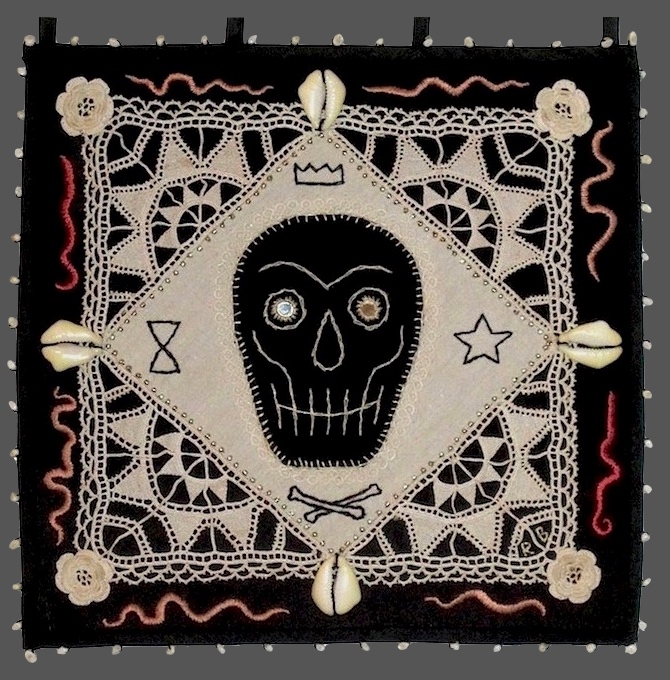
'Doily Roger Memento Mori Flag,' 2017. Mixed media with Victorian doily with shells and hand embroidery. 9.5 x 10.25 inches.
BIKADOROFF Many people in support of the #MeToo movement had pink crocheted hats with what looked like cat ears. I wanted to do something on this ‘end patriarchy’ note, but more like, 'take no prisoners', none of this cutesy pink. The intent should be to make them walk the plank, metaphorically speaking. I had been collecting Victorian lace and hankies and doilies, the kinds of materials older women and grandmothers work with. The square-shaped hankies made me think of pirate flags, even though white is for surrender. So instead I made 'Never Surrender' flags out of them. The material itself can sometimes dictate where a piece wants to go. Resistance Pirate flags made with doilies, tatted by female ancestors. Daughters, granddaughters, never surrender! I wrote an art manifesto for it; the hashtag is #matrianarchy.
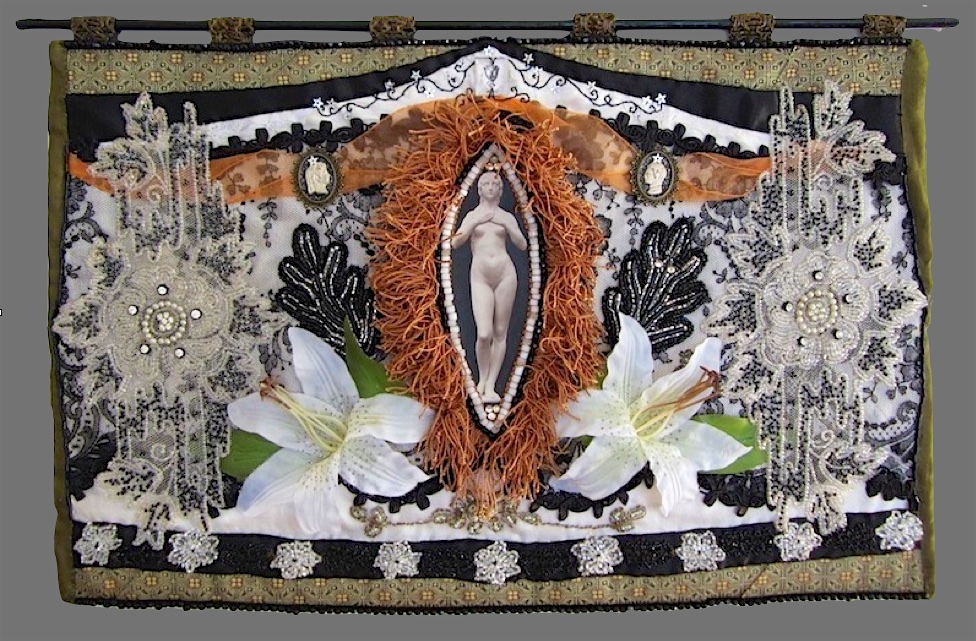
‘The Oleander Standard.’ 2014. Mixed media with antique appliqué and trim, silk, glass beads and hand-embroidery. 19 x 12.5 inches.
SMITH ’The Oleander Standard’ gives a very majestic impression, yet it’s a piece of lacework mixing the old lace, as you say, of grandmothers, but also a photography of youthful female body in the center.
BIKADOROFF This isn't actually lacework, more of an assemblage, but there are some bits of lace in it. Oleander is a beautiful but highly toxic flowering shrub — one leaf can kill an adult human. It reminds me of something an old Victorian lady might use in a murder mystery, like in 'Arsenic and Old Lace'. Although this piece has lilies, I liked the way 'Oleander Standard' sounded. The word ‘standard’ in the title has a double meaning, it can be a banner or flag, like an army would fly, or, a standard that one sets. So in this case, perhaps a standard for a menopausal or post menopausal woman, as she enters the crone Moon phase of her life.
It's all hand sewn, most of the material is antique, but unlike the Doily Roger flags, the materials are not handmade. The beaded appliques once adorned someone's dresses, though, so there's some history there. The photograph in the middle of the fringed, yonic opening is from an old, French postcard depicting a white, nude statue, entitled 'Innocence'. So it represents being all cleaned out, all one's inner skins have now been shed and the power will be held within from here on. That's really all I want to say about the symbolism. I never think about the meaning of a piece when I'm making it, or what the little details mean, it's all intuitive. It's a completed, visual story and the viewer should be reading it that way. Otherwise, it's better to just write something, why make visual art?
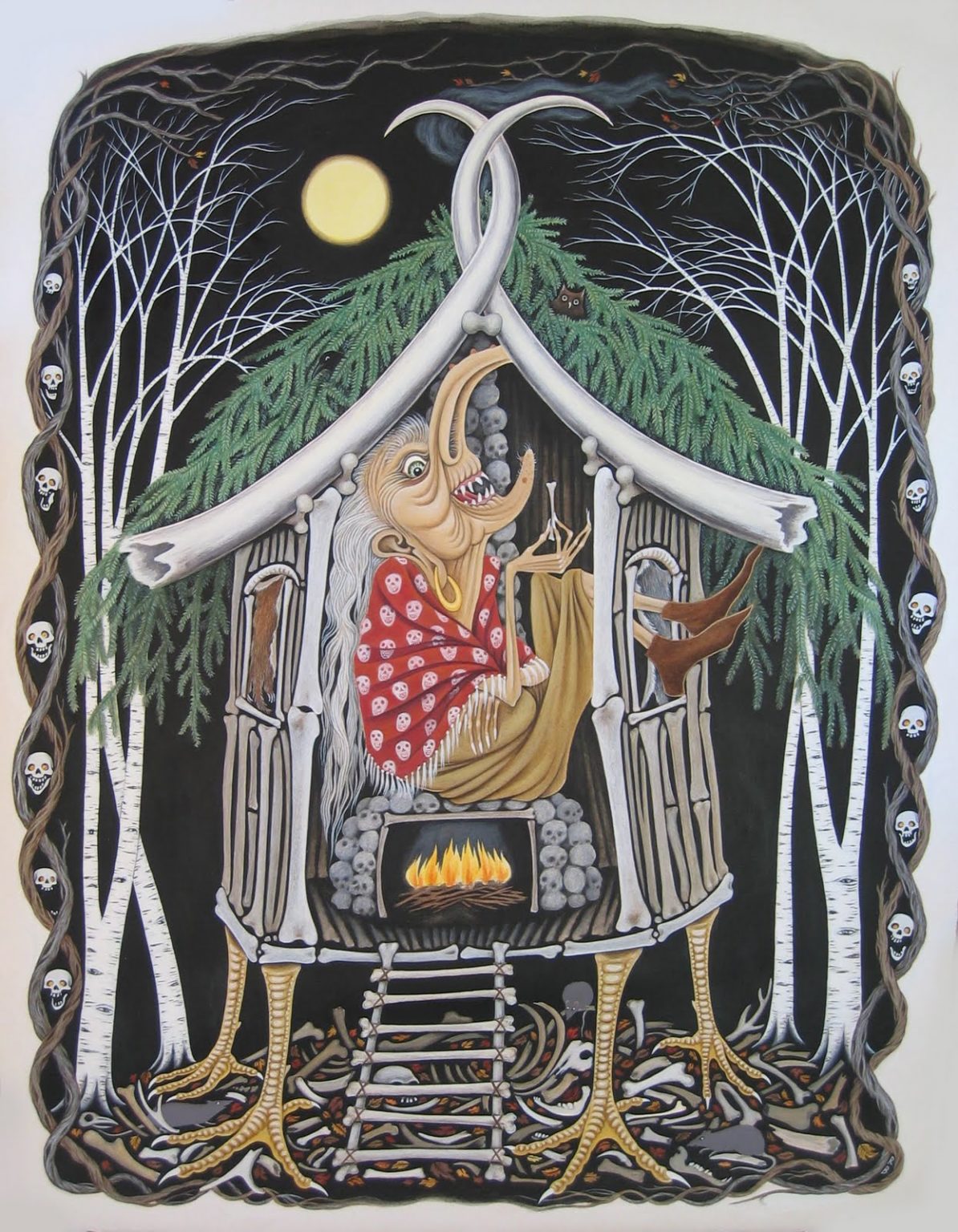
'Baba Yaga.' 2006-2007. Ink, watercolour, acrylic on Arches paper. 18 x 14 inches.
BIKADOROFF Baba Yaga is the all-powerful, "grandmother witch" of Russian and Slavic folklore, who lives in the woods. Those on a quest, such as a princess or knight, will often require her help. She decides whether one is worthy of her help or whether they get eaten, basically. In one particular Russian folk tale, 'The Tsarevna Frog' when the Prince is searching for Vassilisa — kind of a Russian Cinderella — he goes to Baba Yaga and she helps him.
With the spread of orthodox Christianity, the mother earth Goddess of yore was relegated to the dark woods, or the unconscious. As the old ancestor she becomes a crone. But she never loses her power over life and death — her power only becomes stronger and more fearsome.

'The Big Rebertha.' 2010. Acrylic and mixed media on canvas. 36 x 24 inches.
BIKADOROFF This was a painting I did while recovering from an injury — I thought it might help me get my libido back if I painted some erotic paintings. I'd just had some acupuncture and felt energy starting to move. Her look comes from a postcard, an old, black and white photo of opera singer wearing some ostrich feather headgear and lots of eye make-up. She became a jaded Earth Goddess with her legs up, looking rather bored at the continual process of rebirth — her pearls are eggs — she's just waiting for the next conception as if stretching before her next act. She's seen it all, done it all.
SMITH It reminds me of belly dancing and burlesque dancing. It has that feel to it.
BIKADOROFF I like depicting goddesses as burlesque or silent movie stars because I love that era, especially the lighting effects, before colour. In a similar vein, in my mind, I see those black girl groups of the 60s with their big wigs as ancient Egyptian or Greek priestesses. It's not any different, really. They're singing about love in healing tones and the raising of spirits — no different from call to prayer. Rebertha is a goddess as burlesque dancer.
SMITH I like the tension between the bored face and the fully exposed body, as if she’s placidly invulnerable in that mode.
BIKADOROFF It's for sale.
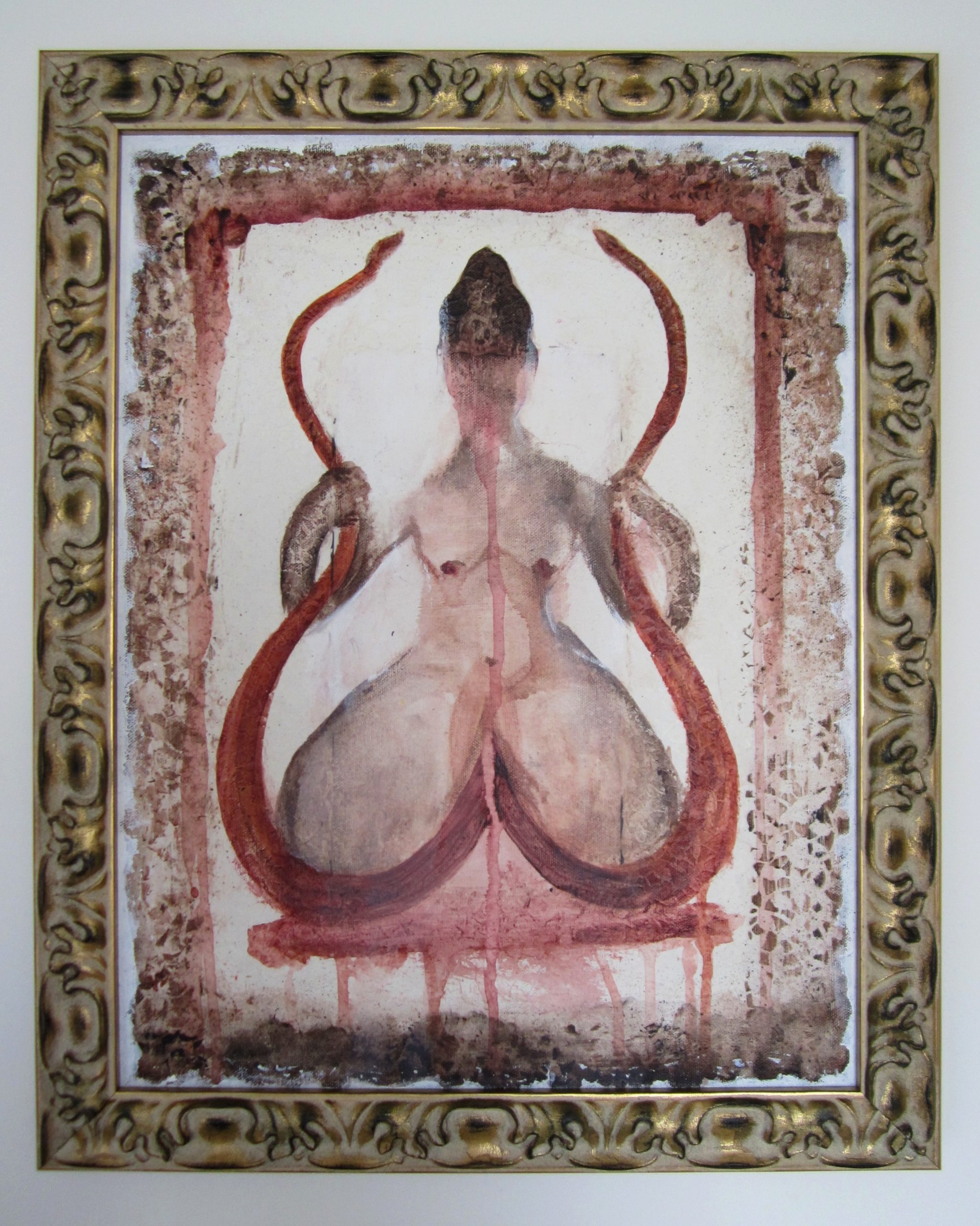
'Python.' 2012. Acrylic on canvas. 18 x 14 inches.
SMITH Python was not a commissioned piece of illustration, but a painting. What drew you to paint it?
BIKADOROFF There's a time in perimenopause when some women will have episodes of abnormal bleeding. I experienced this and it was pretty scary. So I was trying to portray both the feeling of the gore as well as the empowering serpent energy rising up, which is what it actually does in menopausal/post-menopausal years, it rises to the higher chakras.
The woman is sitting on an altar, kind of like those statues at the menstruating goddess temple in India that are covered in 'blood'. Python refers to the Python or Pythia who was an oracle, but also to the shedding of snake skins of the past upon entering crone years. Experiences, lovers, old emotions — everything is just shed from the inside. You're being cleansed.
In mythology, the double serpent goddess heals with one side and wounds or kills with the other. On one hand there is the fear, your life force is literally dropping out of you, and on the other hand there's this new power coming in, a new moon phase.
SMITH In the movie Carrie there is a similar theme.
BIKADOROFF Yes. I watched it recently. The director said the menstruation fear was underlying it all. He had seen the goddess picture I just mentioned and it inspired him.
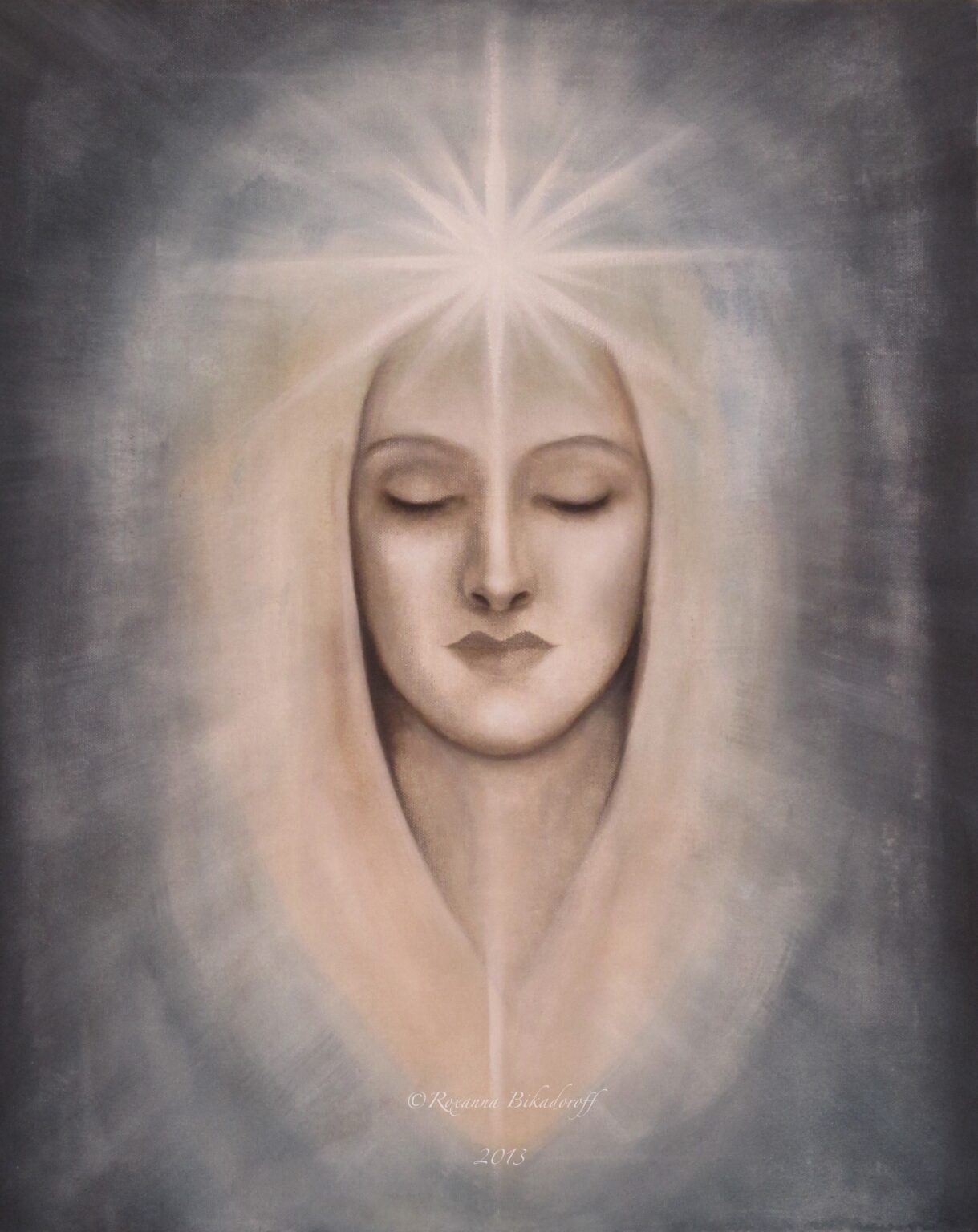
'Sirius Star.' 2013. Acrylic on canvas. 18 x 23 inches.
BIKADOROFF The two paintings ‘Alkaid’ and ‘Sirius’ were channeled paintings, for lack of a better term. It wasn't like I went into complete trance, but close to it.
There used to be a telescope shop in my neighbourhood. I was walking home one day in the late afternoon, in May, and they had a telescope outside aimed at the sky. I asked them what they were looking at. They said, "Sirius...would you like to have a look?” I practice astrology and Sirius is one of the most powerful fixed stars, so of course I did. Though it was still daylight, the star was beaming like a diamond - the name is derived from the Greek 'seirios' which means 'scorcher.' The Egyptians affiliated it with the goddess Isis. I realized then why this star was so revered by the ancients, as it has a strong effect, gets right into your third eye. I went home and started painting it, I painted all night, with no other reference but the star itself. It has a bit of a silent screen look about it, but that was unintentional, it was basically a channelled painting so there is really not much more I can tell you about it. It has a calming effect on my space and everyone who sees it, which is nice.

'Alkaid.' 2015. Acrylic and mixed media on linen. 16 x 20 inches.
BIKADOROFF Alkaid is a star in the constellation of Ursa Major at the very end of the handle of the Big Dipper. Alkaid Benatnasch is the full name, meaning 'Leader of the Daughters of the Bier' in Arabic. All the Arabic star names have been a bit distorted, but that's what it is supposed to mean. Alkaid is the chief mourner of the bier, which is the portable frame on which a coffin or corpse is placed on the way to burial. The stars in the handle are three professional mourners, sisters, that walk behind it. Alkaid, the one at the end, makes sure they're all mourning sadly enough.
The constellation is also prominent in Native American and other mythologies going back to very ancient times, as it circulates the pole star. So she's a multicultural figure and she also has kind of a deco look, which maybe has to do with civilization, not sure. I just get out of the way in these cases and become a vehicle of sorts, which is the best way to paint.
It's perhaps more accurately a personification of the energy of the star. It's hard to see, but she has two weensy rhinestones in her eyes. They sparkle and match the metallic bits and jewels in her kokoshnik (Russian style headdress). ō

ROXANNA BIKADOROFF is a mixed media artist, illustrator, and Tarot and astrology practitioner. Her art and illustration work can be found at her website. She lives in Vancouver.
WHITNEY SMITH is the Publisher and Editor of The Journal of Wild Culture. He lives in Toronto.

Comments
Interesting paintings and…
Interesting paintings and illustrations as well as ideas. She is certainly the daughter of her mother, whom I have the pleasure to know. Both are creative, enveloped in the mythical and exceptionally bright.
Great interview with this…
Great interview with this provocative artist! Really enjoyed the in depth discussion of these pieces. The feminine principle is alive, well and fearless!
Great work, concepts…
Great work, concepts articulated! I love the sensuality, transcending the material through eroticism. Yes, bring back the high-priestesses and the powerful role of the Mother — I had a great one!!!
Add new comment